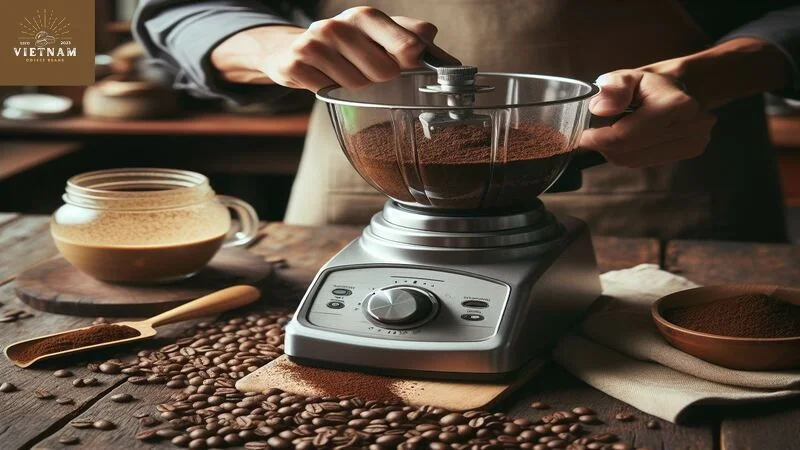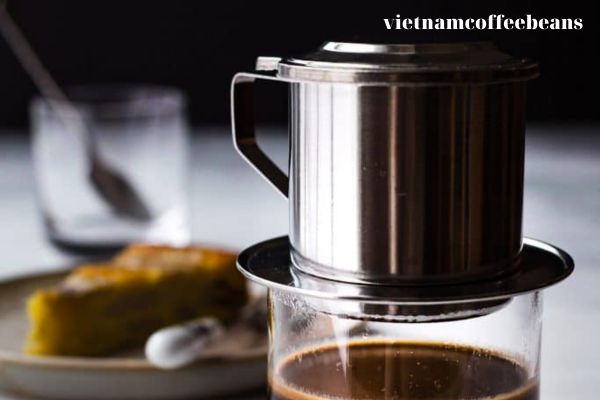Grinding Coffee Beans, a significant step in the coffee brewing process, involves choosing the right grinder, like a burr grinder, to achieve the desired espresso grind size or coarse grind for French Press. As Phi Nguyen barista, from Vietnamcoffeebeans highlights, whether using a manual coffee grinder, a grinding machine, or even a blender, the freshness of roasted coffee beans without pre-ground coffee makes a notable difference.
From espresso machines to drip coffee makers and De’Longhi coffee machines, grinding your own coffee beans at home ensures a richer and more authentic coffee experience. This manual process, essential for both espresso and French Press, transforms beans into fine or coarse grounds, suitable for various coffee makers, enhancing the flavor and aroma of your home-brewed coffee.
Takeaways
- Grind your coffee beans just before brewing for maximum freshness and flavor. Use a few tablespoons of beans at a time.
- Grind to a size fine for your preferred preparation method, like espresso or French press. A medium to medium-fine grind works for most methods.
- Use a manual or electric burr grinder for consistent grind size and uniformity. This optimizes coffee aroma and taste.
- For those creative moments without a grinder at hand, alternative methods like gently crushing the beans with a kitchen tool can still offer a delightful and aromatic brew
How to Grind coffee beans? Guide From Expert Barista
Coffee beans grinding is essential for enhancing flavor and aroma in coffee preparation. Techniques vary from bean milling and coffee crushing to more inventive methods like using a knife or mashing beans, especially when a grinder isn’t available. This process is crucial for achieving the right grind size, from finely ground for espresso to coarser grinds for other brewing methods.
In the following guide, I, Phi Nguyen will explore 5 effective ways to grind coffee beans, ensuring even coffee drinkers without traditional grinders can enjoy a perfect cup. Each technique emphasizes consistency and adaptation to different brewing styles, from home espresso to specialty coffee.
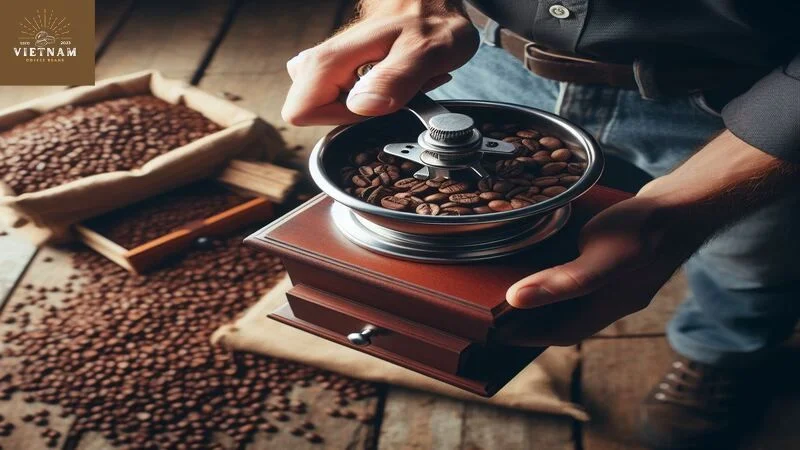
If you’re unsure, use this as a general guide:
- Very coarse: Cold brewed as it steeps in water for between 12 and 24 hours
- Rough: French Press, but feel free to experiment! More and more coffee lovers are questioning the way traditional brewing methods are thought about, including experimenting with French press recipes.
- Medium: Most automatic coffee machines
- Medium Fine: Pour via methods such as V60 or Kalita Wave
- Fine: Espresso, Turkish coffee, Aeropress
- Measure your beans: It’s helpful to have a scale for this step so you know exactly how much coffee you’re using. Enjoy the perfect balance in every cup with the recommended coffee to water ratio of 1:16, a secret to exceptional brewing. For the ideal 12-ounce serving, a precise 25 grams of coffee ensures a flawless taste.
- Effortlessly add beans to the hopper, conveniently located for easy access as you begin your grinding journey. For optimal freshness and perfect brew strength, measure your coffee directly from the bag before each use.
- Tailor your coffee’s texture to your preference with adjustable grind settings, such as those found on the versatile Encore model.
- Customize your grind from fine to coarse with a simple adjustment, giving you complete control over your coffee’s body and flavor.
- Engage your grinder with a simple press of a button, a satisfying step in the grinding process. The grinder intuitively stops when you release the button, ensuring safety and precision in every batch
- Grind effortlessly with grinders equipped with timers, designed to work with just a tap—modern convenience at its best. (The mill in the photos below, a slightly more expensive model from Baratza called the Virtuoso, has this feature.)
- Savor the moment of the first brew and taste, where the nuances of the perfect grind become a delightful reality. So give brewing a try and see what you taste. If you notice that the coffee is brewing too quickly and the coffee tastes sour, you may need to grind it finer. If the brew clogs your machine or the coffee tastes bitter, you may need to use a coarser brew.
How to Grind coffee beans without a grinder?
If you’re in a pinch, you can grind coffee with a few household items, like a mortar and pestle, or smash beans with a rolling pin. Would we recommend this? Not quite – but we have all experienced moments of despair.
“I tried a mortar and pestle and a salt and pepper grinder,” says Yeo. “These are not as effective as a coffee grinder designed to grind coffee beans, likely due to the inconsistent and unevenness of the ground particles created by the process. If your coffee particles are ground inconsistently, it can affect the clarity of the coffee and the flavors in your coffee.
If you go this route, try to use items that you can clean effectively or that you don’t use for other purposes. Coffee contains oils inside that can be difficult to clean. While it may be tempting to turn on your blender to grind coffee, the blades on the bottom of the blender can make cleaning difficult—and your next smoothie will taste like old coffee.
Can you grind coffee beans in a Food Machine?
Yes you can! Again, the consistency won’t be nearly as good as if you bought freshly ground coffee, but grinding it in a good food processor is still an option. Also slightly better than the blender option.
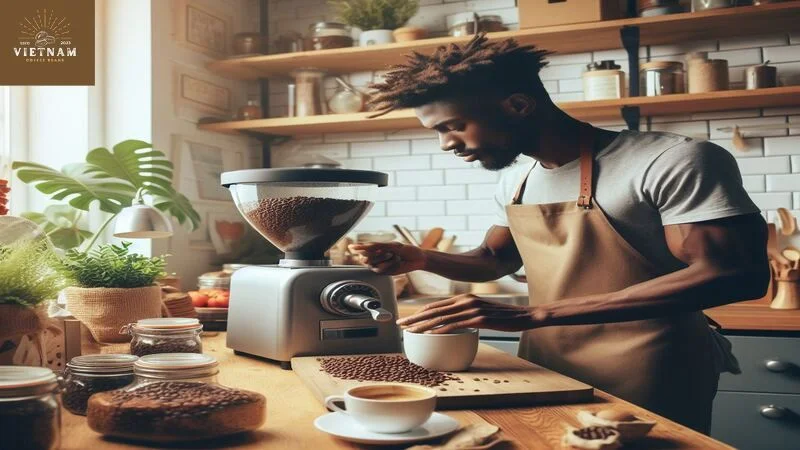
- You’ll need to put more coffee in your food processor than your blender because it likely has a larger work bowl.
- Place a few scoops of beans in the container and PLACE THE LID
- Grind in pulses of about 3 seconds each. Short legumes are better because it avoids overheating the coffee and a bitter taste in the last cup
- Shake or tilt the food processor to get the grinds out and keep the grind as even as possible
- Stop when you have reached the desired grind level
- Add your fresh coffee grounds, add more beans and repeat
Way to grind coffee with Rolling pin
Now let’s really get back to basics! Smashing beans with a rolling pin certainly won’t give you the consistent consistency of a really good brew, but it’s worth a try if you’re up for some fun!
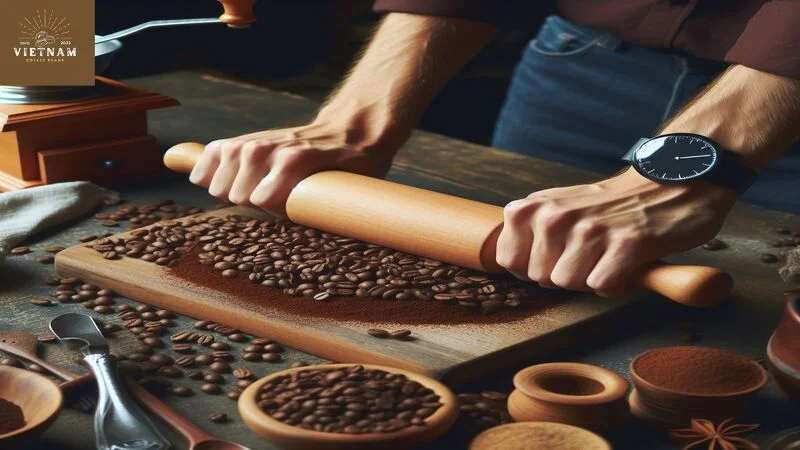
- You may be able to get a finer grind with a rolling pin than with a food processor, so that’s not bad for filter devices.
- Place the beans in the food bag, close the zipper almost completely and squeeze out the air
- Begin beating as if you were crushing cookies for a cheesecake crust
- Once you’ve chopped up most of the whole beans, switch to a rolling technique
- Run the needle over the coffee using gentle but firm pressure. Shake gently every now and then to bring the remains into the middle
- Continue until you reach the desired grind level
Grind coffee with a Blender
They mix and puree, they puree and puree (of course) – they also grind coffee beans! Your stand mixer works a bit like a blade grinder, the not-so-good option among the two types of electric grinders (grill grinders are the best).
Blenders are best for grinding beans to a coarser size. Some blenders even have a special “grinder” setting designed specifically for grinding coffee. Here’s a little step-by-step guide…
- Select a medium-high setting on your blender or the grinder setting if available
- Put the beans in the container and put the lid on (do you realize this part is important??)
- Grind in pulses of about 3 seconds each
- As with the food processor, be sure to gently shake the blender to bring the larger pieces closer to the blade
- Stop when you have reached the desired grind level
- Rinse off once you’re done – you don’t want your next strawberry smoothie to have a hint of coffee!
Guide to grind coffee beans with a Pestle & Mortar
- You can grind it at home using a pestle and mortar, but there is one major downside: you can only grind small amounts at a time. Ideal if you’re making coffee for Secret Santa, but quite time consuming for us humans. That’s how it’s done:
- Place coffee beans in the mortar so that it is about a quarter full
- Use the pestle to crush the whole beans into grindable pieces
- Then continue using circular motions until you reach the desired consistency
- Add more beans and repeat
About grinding coffee beans
Grinding coffee beans is essential for home and professional preparation, utilizing techniques like milling and crushing to affect aroma and taste. Roasting impacts bean preservation and grind consistency, while manual grinding adjusts coarseness.
The coffee bean variety determines grinding speed and technique to adjust grind size for different brew methods. Grinding fresh beans right before brewing maximizes freshness and flavor compared to pre-ground coffee. Fresh grinding is vital for specialty coffee shops and home baristas optimizing coffee flavor.
Main Types of grind coffee beans
If you want to learn tips to carry out grinding like a pro, you need to know the different sizes, textures, and brewing methods you can use to make coffee. Now that you know why grinding your beans is important, here are the most common names and grind sizes that you can try at home or order from a bag of coffee.
- Whole bean coffee is not a grind per se, but it is important to know the term. Whole bean refers to unground coffee and is the best choice for fresh coffee made at home by grinding coffee beans.
- The Coarse Perk grind is a coarse grind that is best suited for immersion brew methods where water has a lot of contact with the coffee during brewing. A coarsely ground sand should have the texture of Poipu Beach sand – gritty and gritty grains that you can see with the naked eye. Compare it to sea salt crystals.
- Auto Drip Grind is a medium grind and is the most common size you will find in the supermarket or on the shelf at your local coffee shop. Automatic drip or medium grind work best in automatic home brewing machines. Automatic drip mills should be about the size and texture of fine beach sand or flaky sea salt.
- Cone fine grind is a medium fine grind for cone filter brewers and should be slightly finer than a medium grind and resemble classic table salt.
- Espresso grind is a fine grind for the pressure extraction brewing method. Coffee ground for espresso should be the same size and consistency as granulated sugar. Turkish grind is an extra-fine, powdery grind used to prepare Turkish coffee. The consistency should resemble all-purpose flour or baker’s cocoa powder.
When grinding coffee beans every morning, use a few tablespoons of coffee to make a good cup of coffee. Grading coffee beans explained, you can grind coffee without a grinder by cracking the beans with a knife or mashing them between two hard surfaces. The size of the grind should be fine for your preferred brewing method to make a great cup of coffee right. Freshly grinding your own beans is the best way to grind for specialty coffee.
Grind coffee beans benefits
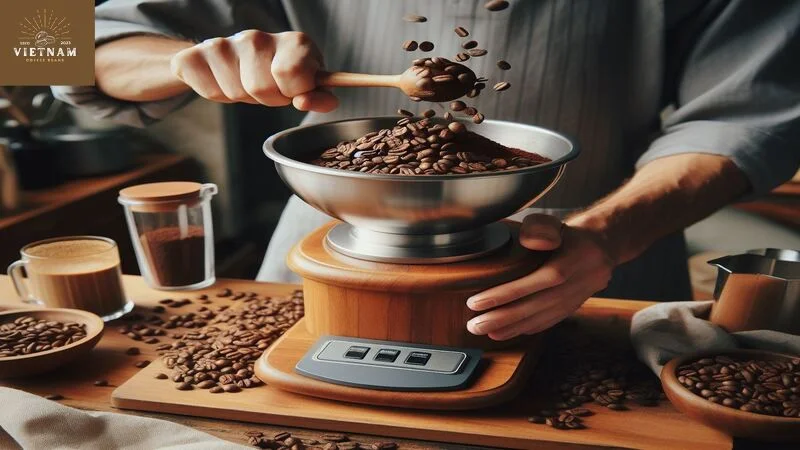
- Grinding coffee beans at home offers numerous benefits, enhancing your home coffee preparation experience.
- By learning how to grind coffee beans yourself like a barista, you ensure the freshest possible flavor, as this maximizes the surface area of the beans for optimal flavor extraction from finely ground coffee in the morning.
- This method surpasses the taste of pre-ground coffee, offering a richer aroma and a fuller coffee taste when you grind coffee beans at home.
- With the ability to adjust the grind size adjustment, from a coarse setting for French Press to a finer grind for espresso making, you achieve perfect brewing method compatibility.
- The consistency and uniformity in grinding, especially with a manual grinder operation, play a crucial role in the quality of your brew.
- This process not only retains the coffee bean variety’s unique characteristics but also contributes to a more flavorful cup of coffee after the coffee beans are ground.
- Moreover, grinding your own coffee fosters a deeper understanding of the coffee bean type and the roasting process, connecting you to the entire coffee production cycle.
- In essence, learning how to grind and grinding more coffee beans is an essential step in crafting a superior cup of specialty coffee, offering an unparalleled, fresh, and personalized coffee experience.
FAQs
Conclusion
In conclusion, freshly grinding whole coffee beans right before brewing is the best way to maximize the bean variety’s unique aromas and flavors in your daily cup of coffee. Grinding just a few tablespoons of beans at a time allows you to grind on demand and enjoy the freshest coffee possible. Investing in a good burr grinder pays off through consistent grind sizes optimized for your preferred brewing method. But you can improvise grinding at home without a fancy grinder by cracking beans with a rolling pin, crushing them between two hard surfaces, or even mashing them with the back of a sturdy knife.
The key is to grind the beans yourself to the ideal fine texture for your particular brewing approach, whether drip, French press, or espresso. Freshly ground beans make a world of difference versus pre-ground coffee in both flavor and aroma. So take the time to grind your own beans and unlock the full experience offered by specialty coffee varieties. The reward will be a better-tasting cup of coffee made right at home.

